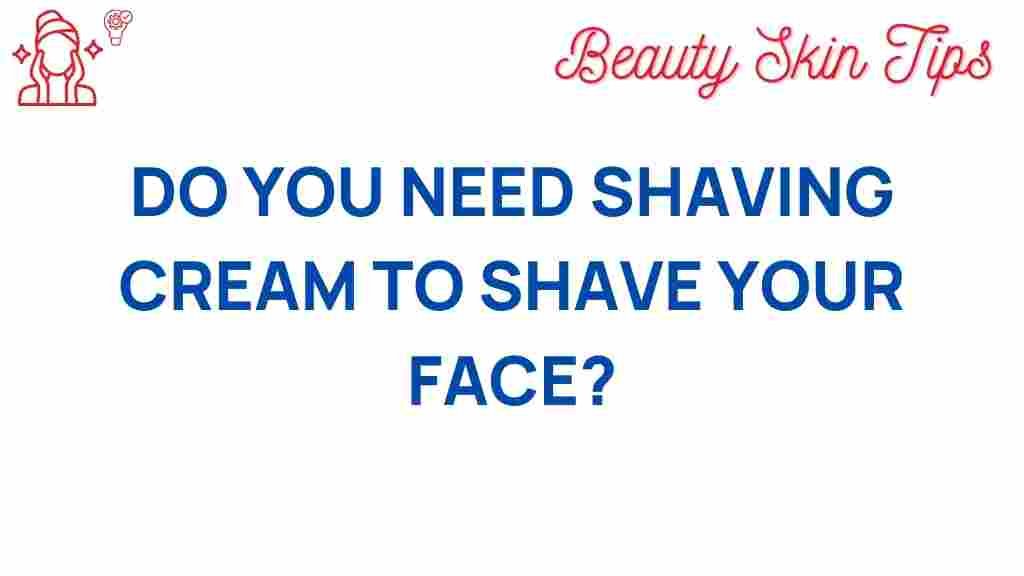Shaving Cream: Is It Essential for a Smooth Shave?
When it comes to achieving a smooth and irritation-free shave, the debate around the necessity of shaving cream has been ongoing. Some swear by it, claiming it is essential for any shaving routine, while others argue that it’s an unnecessary expense. In this article, we will explore the role of shaving cream, alternatives available, and ultimately help you decide whether or not it is essential for your shaving regimen.
The Purpose of Shaving Cream
Shaving cream serves several important functions that contribute to a smooth shave:
- Lubrication: Shaving cream provides a slippery surface, allowing the razor to glide effortlessly over the skin, reducing friction.
- Hydration: Many shaving creams contain moisturizing ingredients that keep the skin hydrated, minimizing dryness and irritation.
- Protection: A good quality shaving cream creates a protective barrier between the razor and your skin, reducing the risk of nicks and cuts.
- Visibility: The lather produced by shaving cream helps you see where you’ve shaved and where you still need to shave.
Types of Shaving Cream
There are several types of shaving creams available on the market, each catering to different skin types and preferences:
- Foam Shaving Cream: This is the most common type, found in aerosol cans. It’s convenient and easy to apply.
- Gel Shaving Cream: Gels provide excellent lubrication and are popular for their cooling effects; they work well for sensitive skin.
- Traditional Shaving Cream: This type comes in a tub or tube and is often used with a shaving brush to create a rich lather.
- Natural Shaving Cream: Made from organic ingredients, this option is ideal for those who prefer eco-friendly products.
Alternatives to Shaving Cream
If you’re considering skipping shaving cream, several alternatives can also provide a smooth shave:
- Soap: Regular soap can work in a pinch, but it may not provide the same level of moisture and protection.
- Conditioner: Hair conditioner can be used as a substitute and provides similar moisturizing benefits.
- Baby Oil: This oil can help lubricate the skin and protect it during shaving.
- Shaving Oil: Specifically designed for shaving, these oils can provide excellent glide and hydration.
Step-by-Step Guide to a Smooth Shave
Whether you choose to use shaving cream or an alternative, following a proper shaving technique is crucial for achieving a smooth result:
- Preparation: Start by washing your face with warm water to open up the pores and soften the hair.
- Apply Shaving Cream: If using shaving cream, apply a generous amount to the area you plan to shave. Use your fingers or a brush to create a rich lather.
- Use a Sharp Razor: Always use a clean and sharp razor to reduce the risk of cuts and irritation.
- Shave with the Grain: Begin shaving in the direction of hair growth to minimize irritation.
- Rinse Frequently: Rinse your razor after every few strokes to keep it clean and effective.
- Aftercare: Rinse your face with cool water and apply a soothing aftershave lotion or moisturizer to hydrate the skin.
Troubleshooting Common Shaving Issues
Even with proper technique, you might encounter some common shaving problems. Here are some tips to troubleshoot:
- Razor Burn: If you experience razor burn, ensure you’re using a sharp razor and avoid shaving over the same area multiple times.
- Ingrown Hairs: Exfoliate the skin before shaving to help prevent ingrown hairs, and consider using a shaving oil for better glide.
- Dry Skin: If your skin feels dry after shaving, switch to a moisturizing shaving cream or consider using a post-shave balm.
- Nicks and Cuts: Use a gentle touch and avoid pressing too hard. If you cut yourself, apply a styptic pencil or antiseptic to the area.
Conclusion: Is Shaving Cream Essential?
The question remains: is shaving cream essential for a smooth shave? While there are effective alternatives, shaving cream undeniably offers significant benefits that enhance the shaving experience. It provides lubrication, hydration, and protection, which can lead to fewer nicks and irritation. Ultimately, whether you choose to use shaving cream or an alternative depends on your skin type, shaving preference, and personal values.
For those looking for a traditional shaving experience, investing in a quality shaving cream can elevate your routine. On the other hand, if you’re in search of a quick, cost-effective solution, exploring alternatives could work just as well. Regardless of your choice, remember that technique plays a vital role in achieving a smooth shave.
For more tips on grooming and self-care, check out our comprehensive guide on personal grooming.
In conclusion, whether you’re a die-hard shaving cream fan or a casual user, understanding the roles and alternatives can help you find the best solution for your shaving needs. Happy shaving!
This article is in the category Skincare and created by BeautySkinTips Team
